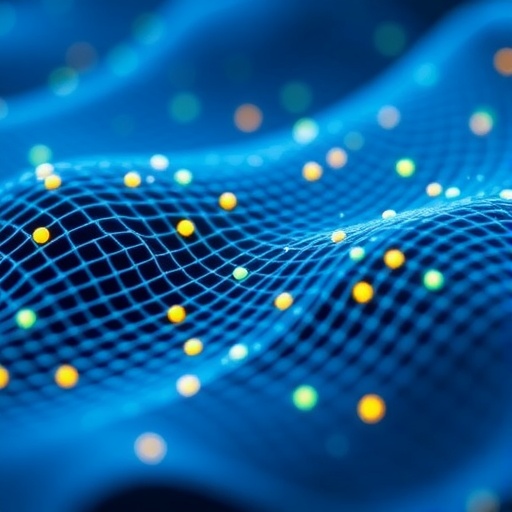In a groundbreaking advance for bioelectronic technology, researchers have unveiled NeuroWorm, a soft, stretchable, and movable microfibre designed to revolutionize long-term neural and muscular monitoring. Drawing inspiration from the natural flexibility and mobility of earthworms, NeuroWorm breaks free from conventional constraints of implanted devices, which traditionally remain fixed and static. This innovation promises a dynamic platform capable of real-time, location-specific recording within living tissues, dramatically enhancing both neuroscience research and human-machine interfacing.
Traditional implantable bioelectronics often struggle with biocompatibility and mechanical mismatch with soft tissues, leading to inflammatory responses, signal degradation, and device failure over time. NeuroWorm addresses these critical challenges through its unique architecture—transforming planar bioelectronic devices into one-dimensional fibres by rolling. This process yields a soft microfibre embedded with longitudinally distributed electrode arrays that are capable of capturing both electrical and biomechanical signals simultaneously. The mobility and stretchability of the microfibre enable it to steer through biological environments, closely mimicking the natural movement patterns of earthworms.
One of the most remarkable features of NeuroWorm is its ability to adjust its position dynamically within the brain or muscle tissues after implantation. This capacity to “steer” the device opens new horizons for targeted monitoring, allowing researchers to refine the location of bioelectrical recordings without additional invasive procedures. This adaptive functionality stands in stark contrast to conventional probes, which suffer from immobilization, limiting signal quality and the ability to study evolving physiological processes.
In vivo experiments using rat models have demonstrated the immense potential of NeuroWorm for long-term, stable bioelectrical monitoring. Once implanted in muscle through a minimally invasive incision, the microfibre maintained high-fidelity recordings of electrical activity for more than 43 weeks. Even more impressively, after an extended implantation period of 54 weeks, histological analysis revealed negligible fibroblast encapsulation—a key factor in device rejection and functional deterioration. This indicates exceptional biocompatibility and minimal foreign body response, a testament to the device’s soft, tissue-mimicking design.
The engineering behind NeuroWorm involves intricate integration of multifunctional sensing elements along a pliable substrate. The microfibre houses arrays of electrodes spaced longitudinally to provide rich spatiotemporal data acquisition. This arrangement allows simultaneous monitoring of both bioelectrical signals, such as muscle action potentials or neural spikes, and biomechanical properties, including strain and movement metrics, providing a multidimensional view of physiological activity in situ.
Moreover, the device’s stretchability permits it to interface with dynamic tissue environments undergoing movement or deformation without compromising its structural integrity or signal fidelity. This key attribute is critical for applications requiring chronic implantation, as the biological milieu continually subjects implanted devices to mechanical stresses that often lead to signal distortion or electrode delamination.
NeuroWorm’s design also facilitates minimally invasive implantation procedures, reducing trauma and risk of infection. Thanks to its slender form factor and ability to fold from two dimensions into a one-dimensional fibre, the device can be introduced through tiny incisions, facilitating patient recovery and expanding the potential for broader clinical applications. This advancement aligns perfectly with ongoing efforts to develop patient-friendly neural interface technologies.
The capacity to longitudinally shift the probe after implantation grants researchers and clinicians unparalleled command over data acquisition sites. This mobility enables real-time adjustments for optimizing signal yield, tracking changes in target tissue regions, or compensating for tissue remodeling over time. Such versatility could be transformative for complex neurological disorders or muscle pathologies where spatially specific monitoring is essential.
From a materials science perspective, the development of NeuroWorm encapsulates the pinnacle of flexible electronics engineering. The seamless integration of electronic components within soft substrates resistant to biological wear and tear marks a significant leap forward in bio-interface design. These advancements pave the way for next-generation devices that harmonize with the human body’s mechanics, reducing complications typically associated with rigid implants.
NeuroWorm is not merely a technological innovation but a paradigm shift, transforming bioelectronic implants from passive, immobile tools to active, intelligent devices capable of “living” with the host specimen. By employing a nature-inspired design principle, this microfibre transcends existing limitations, offering hope for vastly improved chronic monitoring of neural and muscular functions with real-time adaptability.
Looking forward, the implications of this technology extend beyond fundamental research. The ability to steer and reposition implantable sensors dynamically could revolutionize treatments for neurological diseases, facilitate advanced prosthetic control, and enhance brain-computer interfacing systems. As the interface between human physiology and machines grows increasingly sophisticated, NeuroWorm charts a promising path toward seamless integration.
Furthermore, the negligible tissue encapsulation observed after nearly a year of implantation suggests that NeuroWorm could enable truly lifelong monitoring devices, overcoming one of the major obstacles in neurotechnology. This capability not only enhances data reliability but could also reduce the need for repeated surgical interventions, greatly benefiting patient care.
In conclusion, the introduction of NeuroWorm ushers in a new era in chronic bioelectronic interfacing, combining mobility, softness, and multifunctionality in a compact implantable format. Inspired by the humble earthworm, this microfibre exemplifies how biomimicry can solve complex biomedical engineering challenges, standing out as a transformative tool for understanding and interacting with the nervous system more effectively than ever before.
Subject of Research: Long-term implantable soft microfibres for dynamic bioelectronic monitoring of nervous and muscular systems.
Article Title: A movable long-term implantable soft microfibre for dynamic bioelectronics.
Article References:
Xie, R., Han, F., Yu, Q. et al. A movable long-term implantable soft microfibre for dynamic bioelectronics. Nature 645, 648–655 (2025). https://doi.org/10.1038/s41586-025-09344-w
Image Credits: AI Generated




